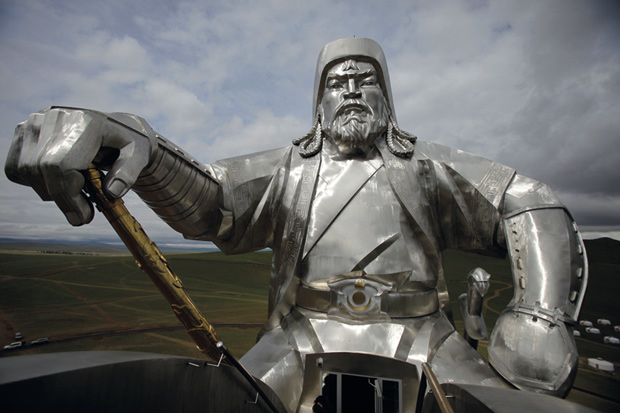Genghis Khan, unlike most Mongols in history, is a household name, regularly misappropriated as a right-wing totem. If we recall the genocidal killing sprees of, say, Stalin and Mao, perhaps it would be more historically accurate to say ‘to the left of Genghis Khan’. In the popular imagination he is the despot’s despot, a one-man killing machine who led his army of mounted archers to triumph after triumph, terrorising and slaughtering by the million to carve out an empire that stretched from the Caspian to the Pacific. His martial conquests place him in the top trio of world conquerors, alongside Alexander the Great and Tamerlane.
If you had the misfortune to live in Central Asia during Genghis’s rampages in the 1220s, you ran the very real risk of being cut in two, beheaded, disemboweled, perhaps even forced to swallow molten metal by his ferocious soldiers. Cities were razed and depopulated, prisoners slain or ordered to march as a shield before the army, in full battle formation. Mongol bloodlust was such that even cats and dogs were killed.
Yet the same man who is said to be responsible for the deaths of a world record 40 million is also noted — admittedly less widely — for his religious tolerance, enlightened diplomacy and championing of women’s rights. As Edward Gibbon noted,
The Catholic inquisitors of Europe who defended nonsense by cruelty, might have been confounded by the example of a barbarian, who anticipated the lessons of philosophy and established by his laws a system of pure theism and perfect toleration.
Gibbon went so far as to posit ‘a singular conformity’ between the religious laws of Genghis and those of John Locke.
Genghis was convinced of his divinely ordained calling to subdue and rule an unruly world, a view accepted by John Man and faithfully maintained by many Mongols today. During the past few months I have received more than 50 impromptu emails from an eccentric young Genghis disciple in Mongolia who told me how he had preserved some of his father’s ashes in fermented mare’s milk and travelled right across the country to sprinkle them over Genghis’s birthplace, honouring him as the father of the nation.
Unlike Tamerlane, whose empire collapsed in short order on his death in 1405, Genghis bequeathed an empire that would endure and expand, and this is Man’s great interest here. He is rightly fascinated by one descendant of the great tyrant in particular: Genghis’s grandson Kublai, generally remembered only as the mysterious potentate in Coleridge’s opium-enhanced poem ‘Kubla Khan’, resident of Xanadu and possessor of a ‘stately pleasure dome’.
Kublai hailed from a junior branch of the family and only managed to take supreme power as Great Khan thanks to his spirited mother and his own diplomatic and military prowess. The sudden and successive deaths of Kublai’s brothers Ariq, Hulagu, Berke and Alghu within the space of a few months from 1264 fortuitously opened the path to power, allowing him to settle and then expand his dominions in the east.
In short order Kublai became the richest and most powerful man on earth. His conquest of China and its deftly handled assimilation into a Mongol-Chinese empire was surely his greatest achievement. In 1271, only seven years after establishing his imperial capital at Xanadu, he shifted his headquarters to Beijing, where his taste for grandeur was given free rein in a remarkable building programme that gave birth to the Imperial City. Man clearly enjoys the delightful fact that China’s current borders were determined not by a Chinese ruler but by a Mongolian warlord.
He does a splendid job of conveying the sheer opulence and grandeur of Kublai’s court, not least the hunting. For 500 kilometres or 40 days’ journey from his new capital the entire countryside was dedicated to hunting. The large game belonged to the emperor: boar, deer, elk, wild asses and wildcats, expertly marshaled to their destruction by 2,000 dog handlers and 10,000 falconers. The figures are Marco Polo’s, and therefore extremely suspect, but you get the point.
Much of this is familiar material and may even be familiar to readers of Man’s earlier works, which include accessible biographies of both Genghis and Kublai. If Mongol history is your thing, David Morgan (The Mongols), Igor de Rachewiltz (The Secret History of the Mongols) or Henry Howorth (History of the Mongols) are surer guides. What Man does, however, is tell a rollicking good story, his historical narrative interspersed with high-spirited travel-writerly digressions, searching for Genghis’s secret burial place one minute, positing a slightly fanciful link between Genghis and Columbus the next. The personal tone is lively and engaging, Man’s wide travels recorded in a series of handsome illustrations.
Man leaves us with a final playful thought which suggests Beijing publishers may not be rushing to have this book translated. For the Chinese, Genghis and Kublai made Mongolia part of China. For Mongols, however, they were the great leaders who made China part of Mongolia.






Comments